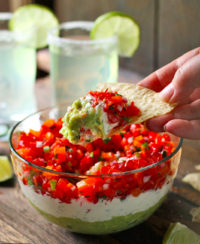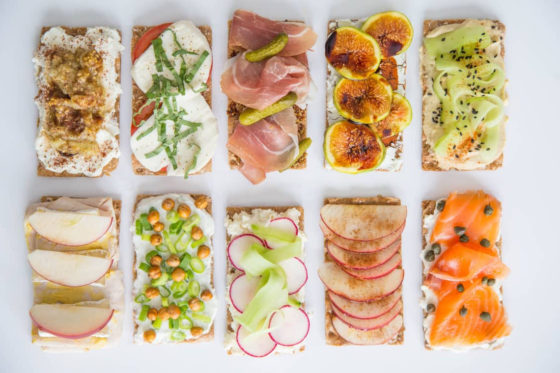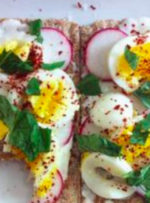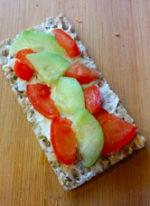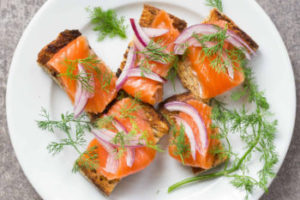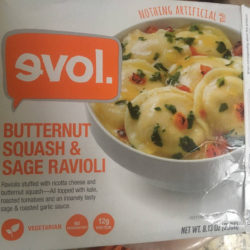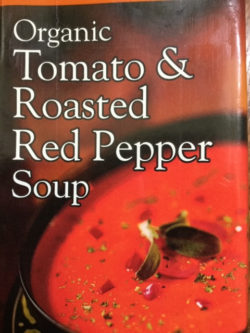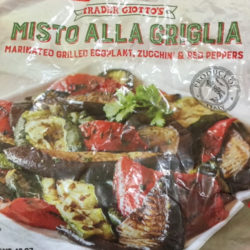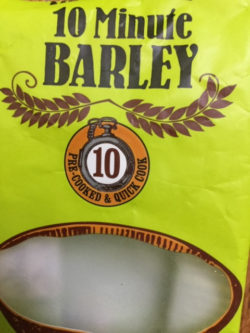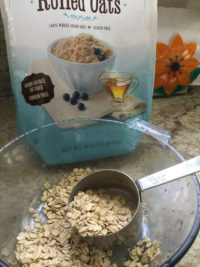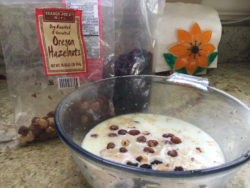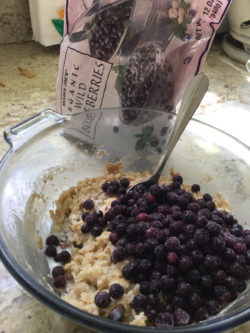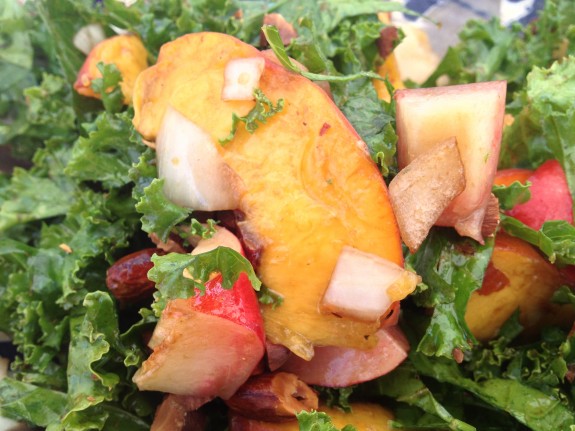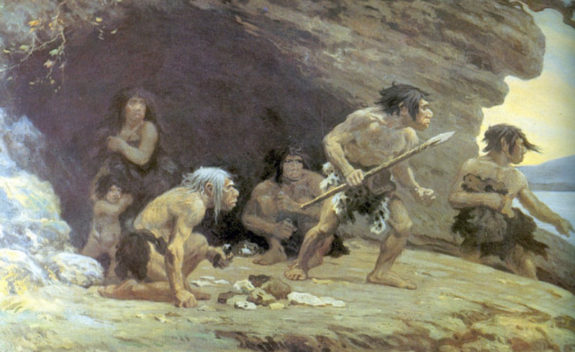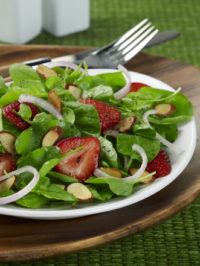Katherine’s Virtual “No-Cook” Cooking 01 Class: Spring into Action!
Would you like to create some fun and amazing recipes that take only three or four ingredients, less than 15 minutes – and don’t even require cooking? No-Cook Cooking 01 will teach you how to cut and prepare onions, tomatoes, peppers, carrots, celery and fresh herbs, resulting in Fresh Salsa, Guacamole, and a Creamy Yogurt Dip, crowd favorites! On top of that accomplishment, these basics will be a foundation for creating hundreds of treasured recipes your family and friends will love. After learning these simple skills, you will discover some of those recipes in my No-Cook Cooking 02 class.
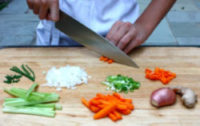 My No-Cook Cooking 01″ Class is for you if you sometimes:
My No-Cook Cooking 01″ Class is for you if you sometimes:
- feel overwhelmed in the grocery store wondering what on earth you need or should buy,
- feel nervous about cooking,
- feel insecure about using knives and kitchen gadgets.
When you’ve registered, I will email you a list of the ingredients and tools you will need for the class. You can also participate by simply watching. If you’d like, repeat the class any time until you feel confident to move on.
To talk to Katherine about the class and/or to sign up, email Katherine at: Katherine@PersonalizedNutrition.com
Swedish New Potatoes with Fresh Dill
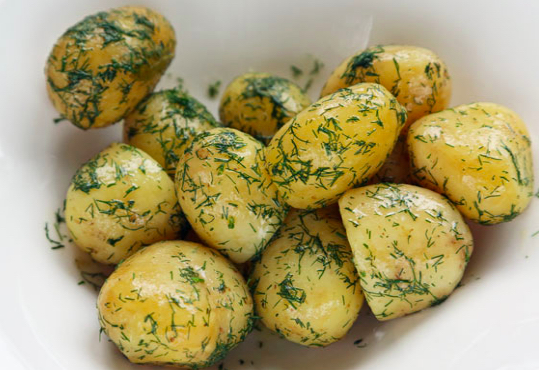 Potatoes are delicious boiled, the simplest and fastest preparation. In Sweden, they are customarily eaten on the same fork as gravlax (cured salmon) and mustard sauce. The combination is delectable. Potatoes are a traditional Swedish dish and served with just about every meal. Historically, Sweden’s fruit and vegetable choices were limited because it lies so far north. Potatoes were an important source of essential vitamins and minerals, preventing lethal deficiencies. Today that legacy continues.
Potatoes are delicious boiled, the simplest and fastest preparation. In Sweden, they are customarily eaten on the same fork as gravlax (cured salmon) and mustard sauce. The combination is delectable. Potatoes are a traditional Swedish dish and served with just about every meal. Historically, Sweden’s fruit and vegetable choices were limited because it lies so far north. Potatoes were an important source of essential vitamins and minerals, preventing lethal deficiencies. Today that legacy continues.
Ingredients:
2 lbs. small thin-skinned “new” potatoes**
1 dill stalk
½ tsp salt
¼ stick butter (2 Tbsp)
2 Tbsp rock salt or Kosher salt
freshly ground black pepper
Two to four Tbsp fresh clipped dill, to taste
Instructions:
1. Wash the potatoes. Just scrub them if you’d like to keep the skin on. Or scrape off the skins if you wish. Rinse the potatoes.
2. Place the larger potatoes over the base of a saucepan and pop the smaller ones on top. Pour in enough boiling water to not quite cover them, add some salt and the stalk of dill.
3. Cover with a tight-fitting lid and simmer gently for between 10 and 20 minutes. The cooking time depends on the variety and size. Test them with a skewer as they must be tender but still firm—overcooking really does spoil them.
4. Drain the potatoes and add the butter, the chopped fresh dill and a little pepper to the pan and then return the potatoes to the pan. Put the lid back on the pan and swirl the pan around to get each potato thoroughly coated.
5. Remove the lid, savor the delicious aroma and then sprinkle with a little rock or Kosher salt before serving them.
** “New” potatoes are freshly harvested young, or small, potatoes. They are the same varieties as their larger counterparts, but are harvested earlier in the season when they are sweet than their older counterparts. Also, because these potatoes are harvested young, their skins are very tender and flaky.
6 Savory Toppings for Crunchy Swedish Hard Bread
Variations for Open-Faced Swedish Hard Bread Sandwiches
Sweden’s Midsummer Festival is the celebration of the summer solstice, the longest day of the year, when the sun never sets.
At the Midsummer feast, it’s always traditional in Sweden to eat seafood, like herring, salmon and shrimp. Gravlax (cured salmon) is a favorite and prominent food in Sweden. Important vegetables and fruits from summer’s first harvest, like radishes, onions, potatoes and strawberries are featured, too. Dill is the herb used in abundance.
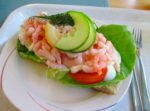
Swedish Shrimps are Tiny and Sweet, Very Different From Their American Cousins. Found in the freezer section of IKEA
With regard to Swedish hard bread toppings, think of what might be in American sandwiches and the options are endless. As well as the typical seafood and vegetables, cheese, cured venison and ham are regular additions. There are even modern versions with out-of-season vegetables using avocado, tomatoes, carrots and beets, you name it!.
Besides the flavor and crunch of Swedish hard bread, the nutrition and low calorie content are added bonuses! In the U.S., WASA bread is the most common brand of Swedish hard bread.
Pickled Herring, Fresh Dill and Sliced Red Onion on 100% Rye Coarse Hard Swedish Bread
Herring, fished locally, is omnipresent on the Swedish table. It is delicious pickled, smoked and grilled. It is a fragile fish – as are sardines and anchovies, its cousins – so it is mostly cured where it can’t be caught right out of the sea.
Since we in the U.S. are unlikely to find fresh herring (recipe below), it can be served with a store-bought version of pickled herring. It is easily found in the refrigerator section of virtually all grocery stores. The most authentic jarred pickled herring is found at IKEA.
Ingredients:
Pickled Herring, from a jar or home-made
Thinly Sliced Red Onion
Chopped Green Onions, optional for color
Thinly Sliced Potatoes, optional for smooth texture
Thinly Sliced Radishes, optional
Dollops of Swedish Mustard, optional
Directions:
Top the hard Swedish bread with thinly sliced boiled potatoes and smother with the pickled herring. Top with sliced red onion and dill.

Home-made Pickled Herring
From SwedishFood.com
Herring spoils fast, so it is almost always cured. Pickled and smoked herring are especially prolific and popular in northern Europe.
7 oz salted herring fillets
(6 fl oz) water*
(4 fl oz) granulated sugar
2 fl oz vinegar, 12% if available
1/2 sliced red onion
6 white pepper corns
2 allspice berries, optional
1 pice of peeled horseradish
1 small piece of ginger (optional)
2 bay leaves (optional)
1. Soak rinsed filets in water while preparing the pickling liquid.
2. Place the water, vinegar and granulated sugar in a saucepan and bring to a boil, stirring until the sugar is dissolved. Leave to cool.
3. Drain the herring fillet, dab them dry with kitchen towel and cut them into ¾ inch wide pieces. Layer with all the remaining ingredients in a glass jar.
4. Pour the cold pickling solution over the herring and transfer to a fridge and keep for at least 24 hours before serving.
5. If the pickling solution becomes a little cloudy, pour it off and make a new solution, but allow it to cool before pouring it on to the herring.
My Favorite Asparagus Recipes

Asparagus, dating back to 3,000 BC, is considered a nutrition superstar because it is loaded with hundreds of vitamins, minerals and newly discovered nutrients called “phytochemicals” (“phyto” is Greek for plant) that impart impressive health benefits. Asparagus (family Liliaceae) possesses a variety of biological properties, such as antioxidant, immune-stimulant, anti-inflammatory, anti-hepatotoxic (helps the liver), and antibacterial.
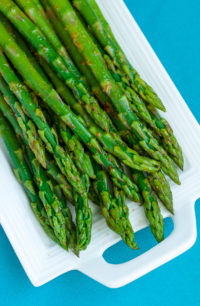 Asparagus is an excellent source of *essential vitamins like B1 (Thiamine), B2 (Riboflavin), and B9 (Folate), and Vitamin C, E and K. It contains some Vitamin A, B5 (Pantothenic Acid), B6 and Choline. It’s a good source of the essential minerals Iron, and contains some Calcium, Magnesium, Manganese, Phosphorus, Potassium and Zinc.
Asparagus is an excellent source of *essential vitamins like B1 (Thiamine), B2 (Riboflavin), and B9 (Folate), and Vitamin C, E and K. It contains some Vitamin A, B5 (Pantothenic Acid), B6 and Choline. It’s a good source of the essential minerals Iron, and contains some Calcium, Magnesium, Manganese, Phosphorus, Potassium and Zinc.
*Vitamins and minerals are considered “essential” when a deficiency would ultimately cause death.
Here are some of my favorite asparagus recipes from my book, “Diet Simple Farm to Table Recipes: 50 New Reasons to Cook In Season!,” along with many other seasonal recipes
Chilled Asparagus in a Creamy Tarragon, Shallot and Roasted Walnut Vinaigrette
Salad of New Potatoes and Asparagus with Lemony Garlic Herb Mayonnaise
Pasta with Pesto, Roasted Asparagus and Cherry Tomatoes
Asparagus Salad in a Vietnamese-Style Dressing
Katherine’s Silver Lining Approach: Your Mediterranean Diet Pantry & Featured Recipe
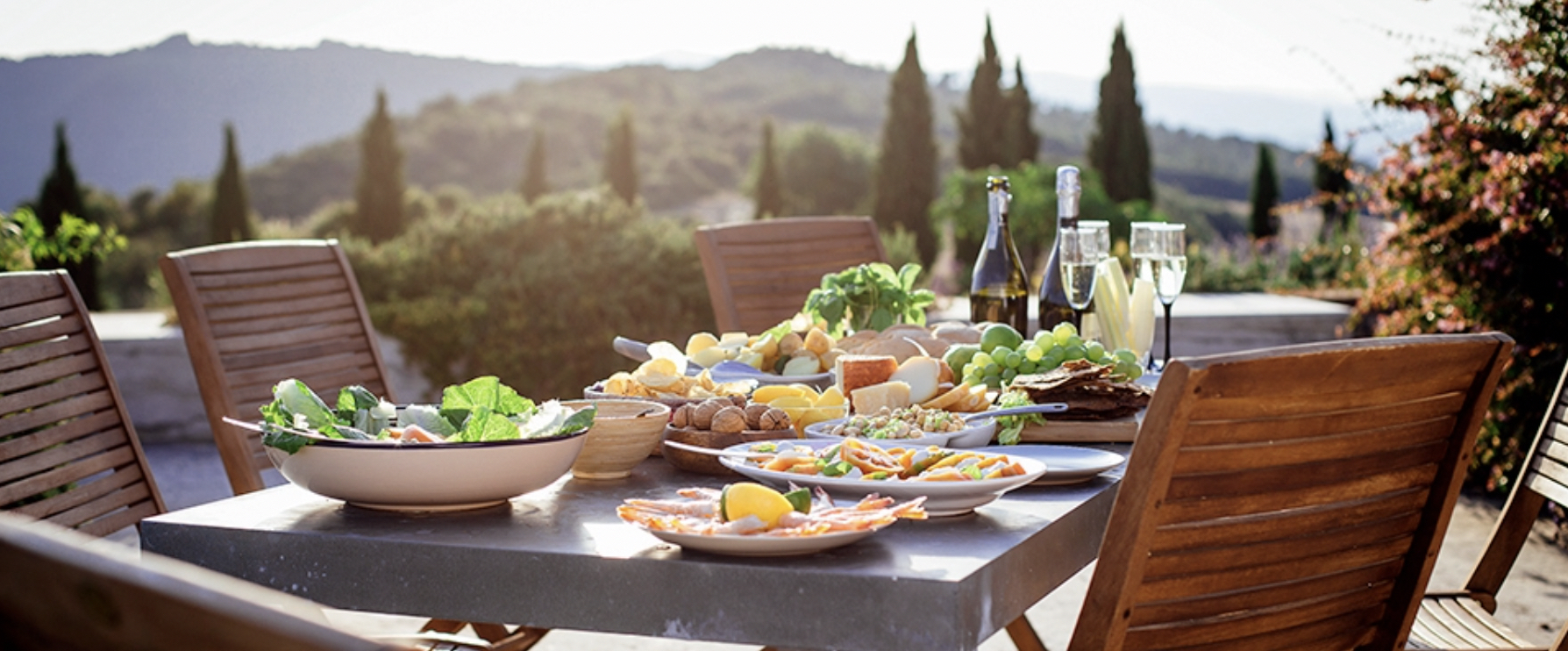
What science has discovered as the ideal diet hasn’t changed for more than half a century. What we’ve learned since then, though, are why and how the diet is so perfect. It’s worth making the switch, for many reasons! For one, it boosts your body’s immune system dramatically, thus, its ability to fight diseases from colds to flu, cancer, heart disease, diabetes, arthritis, Alzheimer’s, even today’s scourge: COVID.
The Mediterranean Diet is a complex diet containing many foods that contribute to its health benefits. It’s plant-based, high in vegetables, fruits, legumes, whole grains, nuts, seeds, fish, low-to-moderate in high fat dairy and red meat (very low in saturated – animal – fat) and the occasional glass of wine. Olive oil is the diet’s principal source of fat.
It was first observed in the 1950s by nutrition scientist, Ancel Keys, that people in Greece, southern Italy, southern France and other countries bordering on the Mediterranean, eating their local food, experienced few nutritional problems and rarely suffered from heart disease. Since then, many studies have confirmed that this mixture of foods we now call the Mediterranean diet has significant properties which may help prevent not only heart disease, cancer, diabetes, Alzheimer’s, dementia, arthritis, many of the diseases of aging, and even weight gain.
While every element in the Mediterranean diet is important, eating fresh, 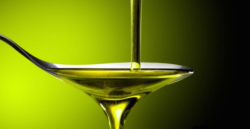 extra-virgin olive oil may trump everything. The type of fat you eat is critical to your health. This is because fat ends up in all of your body’s cells. It acts as a cell lubricant, improves flexibility and communication between cells, and is important for cell metabolism and gene expression. If the fat you eat is saturated – solid at room temperature – as in butter or animal fat – this decreases cellular flexibility and functioning. So, following the Mediterranean diet, but eating the wrong kind of fat, could reduce your health benefits.
extra-virgin olive oil may trump everything. The type of fat you eat is critical to your health. This is because fat ends up in all of your body’s cells. It acts as a cell lubricant, improves flexibility and communication between cells, and is important for cell metabolism and gene expression. If the fat you eat is saturated – solid at room temperature – as in butter or animal fat – this decreases cellular flexibility and functioning. So, following the Mediterranean diet, but eating the wrong kind of fat, could reduce your health benefits.
Olive oil, the staple of the Mediterranean diet, is unique in many ways. First, it’s made from a fruit which is exposed to the elements. This exposure forces olives to synthesize antioxidants and anti-inflammatory nutrients to protect themselves and concentrates the valuable nutrients in the oil, which is high in compounds called polyphenols, Vitamin E and carotenoids, like beta-carotene. New research shows high polyphenol olive oil turns OFF genes that cause the metabolic syndrome, the constellation of high blood pressure, blood sugar and cholesterol.
Polyphenols are also found in wine, tea and cocoa and are known for protecting the heart in many ways – reducing blood clotting, lowering bad (LDL) cholesterol, raising good (HDL) cholesterol and lowering blood pressure. Vitamin E is a well-known antioxidant which helps prevent oxidation and cellular aging and may help prevent diseases such as cancer. Caretenoids are plant compounds giving the olive its color. They’re important for your immune system, your skin, your vision, bones, reproduction, and may reduce cancer risk. Olive oil is also high in heart-healthy monounsaturated fatty acid called Oleic acid.
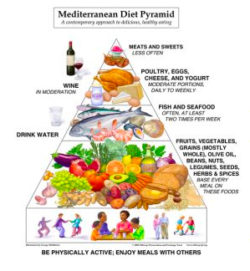 Eating the Mediterranean diet is the most economical way to eat. In fact, it is a diet borne of poverty. The original Mediterraneans, who ate the purest form of the diet in the 1950s and 60s, ate mostly fruits, vegetables, whole grains, nuts, seeds, legumes, fish, and olives, all of which were local. This is all they could afford and it happened to be the healthiest diet on the planet. They were also quite thin and naturally very active in their regular routines. All of these factors contribute to its health benefits
Eating the Mediterranean diet is the most economical way to eat. In fact, it is a diet borne of poverty. The original Mediterraneans, who ate the purest form of the diet in the 1950s and 60s, ate mostly fruits, vegetables, whole grains, nuts, seeds, legumes, fish, and olives, all of which were local. This is all they could afford and it happened to be the healthiest diet on the planet. They were also quite thin and naturally very active in their regular routines. All of these factors contribute to its health benefits
Olive oil’s beneficial health properties, its polyphenol content and acidic pH, degrade over time, as days, weeks, and months go by after harvest. Other factors play a role, too: the harvesting method, the age of the trees, the ripeness of the olives, the processing, and the storage. Since time, heat, and light affect polyphenol content, choose olive oil that:
- Is no more than one year old (look for the harvest date – not a sell-by date – on the label),
- Is in an air-tight, dark glass, or tin container,
- Is stored in a cool environment, and
- Smells and tastes like olives, which could be fruity, grassy, or peppery.
The Mediterranean Diet pantry
This is the perfect way of eating during our collective isolation. It’s inexpensive and most foods can be dry, frozen or canned, when fresh aren’t available, which is the case this time of year. Some examples:
- Canned chopped tomatoes, or any frozen fruits and vegetables
- Dry or canned beans, peas, whole grains such as bulgur, barley, oats, canellini beans, black beans, lentils, chick peas,
- Nuts and seeds
- Fresh lemons, and citrus fruit or vinegar, and olive oil for salad dressings, canola oil for cooking with high heat,
- Fresh onions, garlic, and root vegetables when available,
- Canned wild Alaskan Salmon, herring, anchovies, sardines,
- Whole wheat breads, pasta, crackers and cereals
- Dry or fresh herbs and spices such as basil, rosemary, marjoram, thyme, oregano,
- Yogurt, enough to eat daily for its natural probiotic benefits,
- Cheeses such as Mozzarella, Ricotta, with small amounts of Parmesan and Reggiano.
- Eggs
Katherine’s White Beans with Garlic and Basil
Excerpted from Diet Simple by Katherine Tallmadge, MA, RDN, LD
This is the perfect Mediterranean recipe. My friends love these beans. I love these beans. They’re always a hit. Every time I serve them, I’m asked (begged) for the recipe. They taste deceptively rich and are easy to make. The abundance of fresh basil added at the end fills the house with irresistible aromas. This is a warm and satisfying dish which can be eaten in many ways. My friend David uses them as a dip (what can I say, he`s a shrink and a priest!). My (very healthy) friend Alan loves them so much he eats them for breakfast! I bring them to potlucks.
I love to fill a large plastic container with them in the frig, ladle a heap into a microwave-safe bowl, and heat them up for lunch along with a slice of hearty whole grain bread topped with smoked turkey, salmon, light cheese (or all of the above) – and some crunchy lettuce. One of our favorite ways to eat these beans is with spicy chicken sausage. Just slice a spicy chicken sausage of your choice into a microwave-safe bowl, smother with the beans and pop in the microwave. Together with a greens salad and a tart dressing, you’ve got a winning combination.
I usually double the recipe so I have plenty of servings during the week. Without any meat, it’ll last more than a week in the frig.
4 servings
Ingredients:
1/2 pound dried small white (cannellini) beans, or 24 oz. canned rinsed bean
1 Tbsp Olive Oil
1-1/2 Onion, Chopped
4 Garlic Cloves (more or less to taste)
1 Quart defatted Chicken or Vegetable Stock (only 2 Cups if using canned beans)
Salt and pepper to taste
12 Oz. (3 medium) fresh or canned Tomatoes, drained, peeled and chopped
1 Large Handful of Fresh Basil
Juice from 2 to 4 Lemon (1/4 to ½ cup)
Freshly Ground Pepper, to taste
Directions:
If you’re using dried white beans:
Soak the beans in one quart of water overnight or up to 24 hours. Drain and rinse. Add one quart Chicken Stock (or more if you like the dish more soupy) to the beans along with one clove of garlic and 1/2 onion. Bring to a boil, reduce heat, cover, and simmer 1-1/2 hours or until the beans are almost tender. Add more water or stock to keep moist. Add salt to taste and finish cooking until beans are tender.
Continue with your cooked dried beans or start here if you’re using canned white beans:
Heat the oil in a large, heavy soup pot or casserole and sauté the remaining one onion and garlic over low to medium heat for 10 or 15 minutes or until soft and caramelized. Add the tomatoes, and more salt to taste and bring to a simmer. Simmer about ten minutes then add the beans with their cooking liquid and simmer 15 – 20 minutes. If you used canned beans, use enough stock to keep the beans moist while cooking. At the end of the cooking time, add the fresh basil (it will get bitter if overcooked), fresh lemon juice, and freshly ground pepper. Mix together.
You can also add greens to this dish for more authentic Mediterranean flavors and nutrition.
An Unexpectedly Flavorful Salad with Local Summer Peaches and Kale
Rush to your Farmer’s Market this week! The local peaches are exceptional: sweet, juicy, flavorful, and with a perfect velvety texture. This recipe is a tasty way to feature them at any gathering. And it’s always a favorite.
Fresh Kale & Summer Peach Salad with Toasted Almonds and a Balsamic Vinaigrette
Excerpted from my book: Diet Simple Farm to Table Recipes: 50 New Reasons to Cook in Season!
Serves 6
Vinaigrette:
3 Tablespoons Extra Virgin Olive Oil
1 Tablespoon Balsamic Vinegar
Salt and Pepper to taste
Salad Ingredients:
6 Handfuls of fresh Kale, washed, tough stems removed, and torn into bite-sized pieces or chiffonade
2 Cups Fresh Sliced Summer Peaches
2 Ounces toasted slivered Almonds
½ Sweet Onion, peeled and sliced
In a large bowl, add the olive oil, vinegar, salt and pepper. Whisk until blended. Add the kale, onion, almonds, and peaches. Toss together. Serve immediately.
Paleo Diet Linked with Increased Heart Disease Risk
The “Paleo Diet” is based on the idea that the human genome has not adapted to eating products of agriculture. Paleo dieters eat meat, fish, eggs, nuts, vegetables and few fruits, with no processed foods, grains or dairy products included. Short term, it may have the benefit of weight loss for some because of the sudden exclusion of refined starchy and sugary foods. But the long term picture isn’t so positive, according to a new study in the European Journal of Nutrition.
The study divided participants into groups of people consuming a strict Paleo diet, more relaxed Paleo plans and a traditional healthy diet, based on current health guidelines. The study found that because the strict paleo diet adherents ate zero whole grains, this apparently caused the increase of a compound called trimethylamine-N-oxide (TMAO) in the blood, which is associated a significant rise in cardiovascular disease risk.
The researchers attributed this negative result to the disruption in the gut microbiome caused by the lack of fiber and nutrients contained in whole grains. The gut’s microbiome is the collection of 100 million microorganisms in the digestive tract, which we now know, can make or break your health. Two recently published clinical studies confirm decades of evidence demonstrating that the nutrients and fiber in whole grains, such as whole wheat, oats, barley, rye, brown or wild rice, etc., are essential for overall well-being. They improve gut health (an emerging factor contributing to overall health), the immune system, cardiovascular health, blood sugar regulation, weight loss, and reductions in inflammation, a risk factor for diseases such as colds, arthritis, heart disease and cancer.
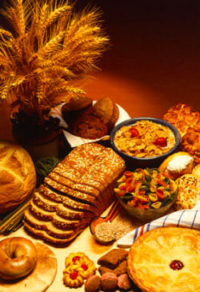 How much whole grain should you be consuming? My advice would be three to four one-ounce servings daily. For instance, two one-ounce slices of whole wheat, whole oat or whole rye toast in the morning, or two slices of whole grain bread for a sandwich at lunch, would be two servings. One cup of cooked brown rice or whole grain pasta would comprise another two servings. It doesn’t take much to receive health benefits. And the calories are lower than you’d expect.
How much whole grain should you be consuming? My advice would be three to four one-ounce servings daily. For instance, two one-ounce slices of whole wheat, whole oat or whole rye toast in the morning, or two slices of whole grain bread for a sandwich at lunch, would be two servings. One cup of cooked brown rice or whole grain pasta would comprise another two servings. It doesn’t take much to receive health benefits. And the calories are lower than you’d expect.
One whole grain serving (about 70 to 100 calories) = 1 ounce dry or 1/2 cup cooked whole grain. Read more about whole grains.
Celebrate the beginning of Fall with my popular Chile Non Carne – a client favorite, and surprisingly, made with cracked wheat.
A favorite hearty salad of mine and my clients is Tabouleh with Chick Peas, Seasonal Vegetables and a Lemony Basil Vinaigrette.
Sweet Strawberries! First Fresh, Local Strawberry Salad of the Season!
Strawberries! Strawberries! Strawberries! Come and get your strawberries! I’m surprised the first strawberries of the season are sweet. I stopped by Quaker Valley Orchards at the Dupont Circle Fresh Farm Market on Sunday (as I always do), tasted one, and the sweet juice ran down my arm – a good sign.
Usually the season’s first strawberries aren’t sweet, but these are – and I recommend them – in case you haven’t guessed already. And lucky for us, Quaker Valley also sells their exceptional produce at the Rose Park Farmer’s Market on Wednesdays from 3:00 to 7:00 pm.
Of course, most of the strawberries I bought – 8 pints – will be popped into my mouth as is. But, this salad is also a great way to celebrate strawberries.
Fresh Strawberry Salad with Goat Cheese, Toasted Almonds and a Balsamic Vinaigrette



